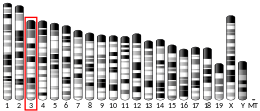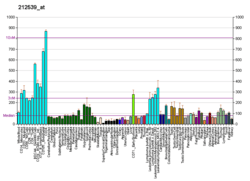CHD1L
Chromodomain-helicase-DNA-binding protein 1-like (ALC1) is an enzyme that in humans is encoded by the CHD1L gene.[5][6] It has been implicated in chromatin remodeling and DNA relaxation process required for DNA replication, repair and transcription. The ALC1 comprises ATPase domain and macro domain. On the basis of homology within the ATPase domain, ALC1 belongs to Snf2 family[7].
Function
In development
CHD1L, a DNA helicase, possesses chromatin remodeling activity and interacts with PARP1/PARylation in regulating pluripotency during developmental reprogramming. The CHD1L macro-domain interacts with the PAR moiety of PARylated-PARP1 to facilitate early-stage reprogramming and pluripotency in stem cells.[8] It appears that CHD1L expression is vital for early events in embryonic development. [9]
In DNA repair
To allow the critical cellular process of DNA repair, the chromatin must be remodeled at sites of damage. CHD1L (ALC1) a chromatin remodeling protein, acts very early in DNA repair. Chromatin relaxation occurs rapidly at the site of a DNA damage.[10] This process is initiated by PARP1 protein that starts to appear at DNA damage in less than a second, with half maximum accumulation within 1.6 seconds after the damage occurs.[11] Next the chromatin remodeler CHD1L (ALC1) quickly attaches to the product of PARP1, and completes arrival at the DNA damage within 10 seconds of the damage.[10] About half of the maximum chromatin relaxation, due to action of CHD1L (ALC1), occurs by 10 seconds.[10] This then allows recruitment of the DNA repair enzyme MRE11, to initiate DNA repair, within 13 seconds.[11] MRE11 is involved in homologous recombinational repair. CHD1L (ALC1) is also required for repair of UV-damaged chromatin through nucleotide excision repair.[12]
Related gene problems
With 1q21.1 deletion syndrome a disturbance occurs, which leads to increased DNA breaks. The role of CHD1L is similar to that of helicase with the Werner syndrome[13]
References
- GRCh38: Ensembl release 89: ENSG00000131778 - Ensembl, May 2017
- GRCm38: Ensembl release 89: ENSMUSG00000028089 - Ensembl, May 2017
- "Human PubMed Reference:". National Center for Biotechnology Information, U.S. National Library of Medicine.
- "Mouse PubMed Reference:". National Center for Biotechnology Information, U.S. National Library of Medicine.
- Mao M, Fu G, Wu JS, Zhang QH, Zhou J, Kan LX, Huang QH, He KL, Gu BW, Han ZG, Shen Y, Gu J, Yu YP, Xu SH, Wang YX, Chen SJ, Chen Z (July 1998). "Identification of genes expressed in human CD34(+) hematopoietic stem/progenitor cells by expressed sequence tags and efficient full-length cDNA cloning". Proceedings of the National Academy of Sciences of the United States of America. 95 (14): 8175–80. doi:10.1073/pnas.95.14.8175. PMC 20949. PMID 9653160.
- "Entrez Gene: CHD1L chromodomain helicase DNA binding protein 1-like".
- Flaus A, Martin DM, Barton GJ, Owen-Hughes T (2006-05-31). "Identification of multiple distinct Snf2 subfamilies with conserved structural motifs". Nucleic Acids Research. 34 (10): 2887–905. doi:10.1093/nar/gkl295. PMC 1474054. PMID 16738128.
- Jiang BH, Chen WY, Li HY, Chien Y, Chang WC, Hsieh PC, Wu P, Chen CY, Song HY, Chien CS, Sung YJ, Chiou SH (October 2015). "CHD1L Regulated PARP1-Driven Pluripotency and Chromatin Remodeling During the Early-Stage Cell Reprogramming". Stem Cells. 33 (10): 2961–72. doi:10.1002/stem.2116. PMC 4832376. PMID 26201266.
- Snider AC, Leong D, Wang QT, Wysocka J, Yao MW, Scott MP (February 2013). "The chromatin remodeling factor Chd1l is required in the preimplantation embryo". Biology Open. 2 (2): 121–31. doi:10.1242/bio.20122949. PMC 3575647. PMID 23429299.
- Sellou H, Lebeaupin T, Chapuis C, Smith R, Hegele A, Singh HR, Kozlowski M, Bultmann S, Ladurner AG, Timinszky G, Huet S (December 2016). "The poly(ADP-ribose)-dependent chromatin remodeler Alc1 induces local chromatin relaxation upon DNA damage". Molecular Biology of the Cell. 27 (24): 3791–3799. doi:10.1091/mbc.E16-05-0269. PMC 5170603. PMID 27733626.
- Haince JF, McDonald D, Rodrigue A, Déry U, Masson JY, Hendzel MJ, Poirier GG (January 2008). "PARP1-dependent kinetics of recruitment of MRE11 and NBS1 proteins to multiple DNA damage sites". The Journal of Biological Chemistry. 283 (2): 1197–208. doi:10.1074/jbc.M706734200. PMID 18025084.
- Pines A, Vrouwe MG, Marteijn JA, Typas D, Luijsterburg MS, Cansoy M, Hensbergen P, Deelder A, de Groot A, Matsumoto S, Sugasawa K, Thoma N, Vermeulen W, Vrieling H, Mullenders L (October 2012). "PARP1 promotes nucleotide excision repair through DDB2 stabilization and recruitment of ALC1". The Journal of Cell Biology. 199 (2): 235–49. doi:10.1083/jcb.201112132. PMC 3471223. PMID 23045548.
- Harvard C (2011). "Understanding the impact of 1q21.1 copy number variant". Orphanet Journal of Rare Diseases. 6: 54. doi:10.1186/1750-1172-6-54. PMC 3180300. PMID 21824431.
External links
- Human CHD1L genome location and CHD1L gene details page in the UCSC Genome Browser.
Further reading
- Matoba R, Okubo K, Hori N, Fukushima A, Matsubara K (September 1994). "The addition of 5'-coding information to a 3'-directed cDNA library improves analysis of gene expression". Gene. 146 (2): 199–207. doi:10.1016/0378-1119(94)90293-3. PMID 8076819.
- Maruyama K, Sugano S (January 1994). "Oligo-capping: a simple method to replace the cap structure of eukaryotic mRNAs with oligoribonucleotides". Gene. 138 (1–2): 171–4. doi:10.1016/0378-1119(94)90802-8. PMID 8125298.
- Suzuki Y, Yoshitomo-Nakagawa K, Maruyama K, Suyama A, Sugano S (October 1997). "Construction and characterization of a full length-enriched and a 5'-end-enriched cDNA library". Gene. 200 (1–2): 149–56. doi:10.1016/S0378-1119(97)00411-3. PMID 9373149.
- Zhang QH, Ye M, Wu XY, Ren SX, Zhao M, Zhao CJ, Fu G, Shen Y, Fan HY, Lu G, Zhong M, Xu XR, Han ZG, Zhang JW, Tao J, Huang QH, Zhou J, Hu GX, Gu J, Chen SJ, Chen Z (October 2000). "Cloning and functional analysis of cDNAs with open reading frames for 300 previously undefined genes expressed in CD34+ hematopoietic stem/progenitor cells". Genome Research. 10 (10): 1546–60. doi:10.1101/gr.140200. PMC 310934. PMID 11042152.
- Harrington JJ, Sherf B, Rundlett S, Jackson PD, Perry R, Cain S, Leventhal C, Thornton M, Ramachandran R, Whittington J, Lerner L, Costanzo D, McElligott K, Boozer S, Mays R, Smith E, Veloso N, Klika A, Hess J, Cothren K, Lo K, Offenbacher J, Danzig J, Ducar M (May 2001). "Creation of genome-wide protein expression libraries using random activation of gene expression". Nature Biotechnology. 19 (5): 440–5. doi:10.1038/88107. PMID 11329013.
- Karras GI, Kustatscher G, Buhecha HR, Allen MD, Pugieux C, Sait F, Bycroft M, Ladurner AG (June 2005). "The macro domain is an ADP-ribose binding module". The EMBO Journal. 24 (11): 1911–20. doi:10.1038/sj.emboj.7600664. PMC 1142602. PMID 15902274.
- Kimura K, Wakamatsu A, Suzuki Y, Ota T, Nishikawa T, Yamashita R, Yamamoto J, Sekine M, Tsuritani K, Wakaguri H, Ishii S, Sugiyama T, Saito K, Isono Y, Irie R, Kushida N, Yoneyama T, Otsuka R, Kanda K, Yokoi T, Kondo H, Wagatsuma M, Murakawa K, Ishida S, Ishibashi T, Takahashi-Fujii A, Tanase T, Nagai K, Kikuchi H, Nakai K, Isogai T, Sugano S (January 2006). "Diversification of transcriptional modulation: large-scale identification and characterization of putative alternative promoters of human genes". Genome Research. 16 (1): 55–65. doi:10.1101/gr.4039406. PMC 1356129. PMID 16344560.





